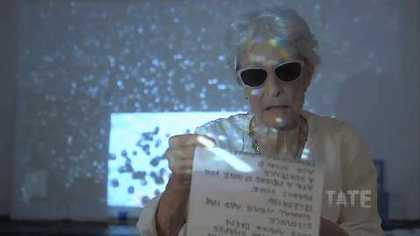
Joan Jonas, Stream or River, Flight or Pattern (2016 - 2017) © Joan Jonas : Artists Rights Society (ARS), New York : DACS, London.
Joan Jonas (born 1936) is a pioneer of performance, video and installation who has pushed the boundaries of art for the last five decades. After studying sculpture and art history she became one of the founding figures of performance when it first emerged in New York in the 1960s and 1970s. Throughout her career Jonas has constantly experimented with different media and continues to influence generations of younger artists.
Drawing inspiration from different cultures and traditions, Jonas’s imagery draws on diverse sources, from fairy tales to essays, from myths to local folklore. She adapts these sources so they relate to contemporary life. She uses masks, mirrors and video screens to create a complex layering of images. Both poetic and political, Jonas’s work conveys her lifelong interest in movement, music, female identity, the environment, and natural and urban landscapes.
Jonas often revisits and re-adapts earlier works and performances to create new installations and to incorporate a live element into them. The layout and order of the exhibition, which was put together in close collaboration with the artist, is based on Jonas’s constant mirroring of recurring themes and motifs. Throughout the exhibition, it is Jonas’s voice that guides you.
Room 1

Joan Jonas in her New York studio, photographed by Toby Coulson © Toby Coulson
This room shows the masks and objects that surround the artist in her New York loft and which are a constant source of inspiration for her.
The idea of a prop had a clear relationship to sculpture. Nevertheless, the prop in my work is usually not a piece of sculpture in itself but exists as a part of the whole: the prop can be moved or can move the performer or the set of the performance. The prop generates movement and one such object, or group of objects, partly represents the content of the work.
I always thought the activity of putting one object next to another was like making a visual poem.
Over the years friends occasionally add to my collection. Maybe this desire to collect was inspired by my great uncle’s antique store in New Hampshire.
I started using masks after I went to Japan in 1970 and saw the Noh theater. Over the years I’ve found different masks for almost every one of my pieces. I think they are incredible, very powerful. They hide my face and suggest alternative identities. A friend gave me three very strange screen masks found in Cape Breton thought to be from Masonic rituals. I like theatrical masks of all kinds and have used many from South America and Mexico. I have many wonderful papier-mâché masks representing all kinds of animals – dogs, sheep, fox rabbit etc.
These masks inspire me to move and behave in a different way. If you put a mask on you can enter another world. The perception of movement is transformed.
Joan Jonas
Room 2

Joan Jonas, Delay Delay, 1972, performance, Lower West Side, New York, NY, 1972. Photo by Gianfranco Gorgoni © 2018 Joan Jonas
My early work developed in a particular context and place. In the 1960s, some parts of New York looked like ruins – parts of the Lower West Side, for example, and the docks nearby along the Hudson River. These were places to explore. SoHo was relatively empty, and artists were able to move into old, recently abandoned factory lofts there that had the beauty of another time. It wasn’t expensive to find a place to perform or exhibit one’s work, and you could work on these streets, lots and docks without an official permit. My performance and video reflected that setting. It was an atmosphere grainy and rough. I made my early black-and-white videos and performances near the docks, in my loft, or in ground-floor spaces in SoHo like 112 Greene Street and LoGiudice Gallery on Broome Street.
Room 3
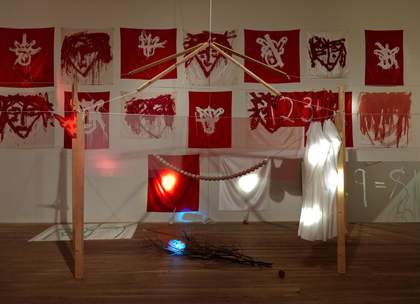
Joan Jonas The Juniper Tree 1976, reconstructed 1994 © Joan Jonas
When I started using stories with The Juniper Tree, which is a Grimm Brothers story, there was a continuous voice telling the story and I worked against it. I don’t illustrate the stories, but I represent and react to them – find ways to make my own language in relation to the story.
The installation The Juniper Tree evolved from a performance Jonas originally created for children. It is one of her earliest installations and the first to be explicitly based on a narrative. The Juniper Tree refers to the Brothers Grimm fairy tale about a little boy who is beheaded by his wicked stepmother and eaten by his father, before being reincarnated as a beautiful bird with the help of his stepsister. After killing his stepmother by dropping a millstone on her head, he is turned back into a boy and lives happily ever after with his father and stepsister.
The Juniper Tree was performed in a number of different places, evolving radically from its first presentation at the ICA Philadelphia in 1976, through several versions (including at the Whitechapel Gallery in London), to the last iteration performed in Jonas’s loft in 1978. The set, designed and developed particularly for this version, became the installation The Juniper Tree, on display in the exhibition.
Props, relics, paintings and drawings are included in the installation, as well as garments and constructions used in the last version of the performance. The paintings on redand- white silk were made during each of the performances and added one by one to the backdrop. In an audio soundtrack Jonas recites the story of The Juniper Tree alongside musical contributions and songs performed by the American choreographer Simone Forti. The projection shows photographs from the various performances, highlighting their importance in the development of the work.
Room 4
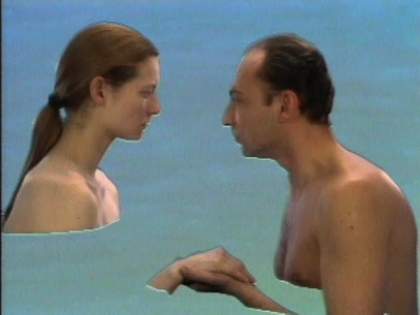
Still from Volcano Saga 1985–89 © 2018 Joan Jonas: Artists Rights Society (ARS), New York: DACS, London
With Volcano Saga I begin synthesising my development of female character, using the story as mirror and the volcanic landscapes as representations of this particular narrative. Here (in Iceland) the psyche is connected to the elements, which, as in Wind, become characters.
Like many of Jonas’s works, the video Volcano Saga evolved from a performance. The artist draws upon a 13th century Icelandic folk epic, the Laxdaela Saga, about a woman who marries four times. The protagonist, Gudrun, tells the seer,Gest, about four dreams which Gest interprets to be about Gudrun’s future. Jonas cast Tilda Swinton as Gudrun and Ron Vawter as the seer. By shooting their scenes in a studio then superimposing views of Iceland over them, Jonas creates a deliberately artificial and dream-like effect.
Jonas begins the film by speaking about an accident that happened to her in Iceland: wind blew her car off the road while she was gathering footage for this work. For the artist, this story connects the present moment to the life of Gudrun and the power of nature in Iceland. The sound of the wind can be heard throughout the video, as well as music by the American experimental composer Alvin Lucier. In 1994, Jonas developed Volcano Saga into a multimedia installation with the same title.
Room 5
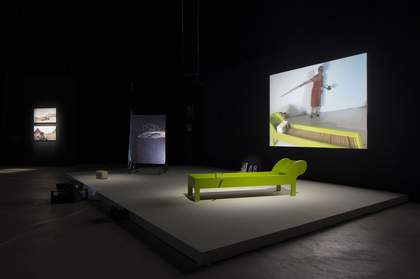
Joan Jonas, Lines in the Sand, 2004
The Renaissance Society at the University of Chicago
Photo credit: Tom Van Eynde
When I began working more directly with narrative – with fairy tales, myth, the writings of H.D. – I was exploring the place of women in history, as outsiders, witches, storytellers. I have always been interested in the poetics of how women are depicted, which is political, of course.
Lines in the Sand explores the myth of the Trojan War. According to historian Robert Grave it was a trade war and not caused by a woman, Helen of Troy. The work is based on the epic poem Helen in Egypt 1961, by American writer and poet H. D. (Hilda Doolittle), in which it is told that Helen goes to Egypt instead of Troy. This is also an early classical Greek tale. In Lines in the Sand Jonas refers to this plot and works with the idea that a ghostly double of Helen existed in Troy.
Jonas continues the play with real and fake by transferring the myth’s setting to contemporary Las Vegas, showing footage of the Egyptian-style Luxor Hotel. She also includes photographs from her grandmother’s trip to Egypt in 1910, representing the real.
Inside the My New Theater box is a video called Pillow Talk, taken from the medieval Irish epic The Táin, showing a couple arguing about who has more possessions. Jonas explains: "Their often humorous dialogue echoes the trade war between Troy and Greece and demonstrates how arguments over possessions begin at home."
The title Lines in the Sand refers to how western powers have divided up countries of the Middle East, and to more recent political events. Jonas edited the work before and after the events of 9/11 in New York, and has written: "When I was editing Lines in the Sand, with every choice I made, I was thinking of the situation in the world."
Room 6
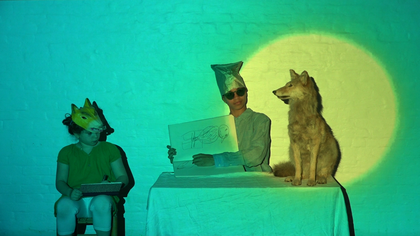
Joan Jonas, Stream or River, Flight or Pattern, 2016-2017. © 2018 Joan Jonas : Artists Rights Society (ARS), New York : DACS, London.
In my works, I’m always experimenting with new ways of making a drawing. These are new bird drawings on the large boards in Stream or River, Flight or Pattern. Birds become the dominant element in the piece, partly because of the drawings. The cries of the birds also dominate the soundtrack, with the woman’s song – that links the bird with the human.
The video projections in this work tell a narrative connected to Jonas’s travels, bringing together images of Venetian mosaics, a bird sanctuary in Singapore, a graveyard in Genoa, redwood forests around San Francisco, landscapes in northern Spain, India and Canada, as well as traffic and the making of local crafts and rituals in Vietnam. In one video, a multi-layered effect is created by performers’ shadows which become part of the projection. Jonas’s drawings of birds have been enlarged and transferred onto the boards. The paper kites are objects the artist found in a small village close to Hanoi, Vietnam. They reflect both Jonas’s interest in the materiality of paper and her practice of working with objects she collects during her travels. Here they also suggest the idea of flight, as the installation’s individual elements are tied together by the theme of the bird. Investigations into nature and animals, especially endangered species, have taken on greater importance in Jonas’s work in recent years, also appearing in installations such as Reanimation 2010/2012/2013, on display as part of this exhibition in the East Tank, Level 0.
Room 7
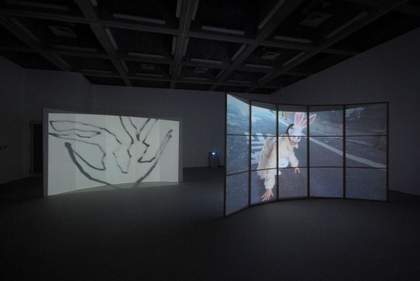
Installation view of Double Lunar Rabbits 2010
from Light Time Tales, Malmö Konsthall, Malmö, Sweden, 2015. Photo: Helene Toresdotter.
Courtesy: Malmö Konsthal
In Double Lunar Rabbits 2010, I explore the image of the rabbit in the moon, familiar in Japan. Finding a similar myth in the Aztec tradition, I juxtapose the two stories in an installation involving fragile sculptural forms as a doubled stage for projected video … I thought to design curved screens as a way to display Double Lunar Rabbits. Later such screens were designed for Reanimation.
The two-channel video Double Lunar Rabbits is never completely visible: the curve of the screens mean images disappear from view as the spectator walks past. Shot in different locations across Kitakyushu in Japan – including a narrow brick tunnel, a street, and a field –the work is projected onto paper and wood screens inspired by traditional Japanese sho-ji (room dividers or screens). The narrative, from the traditional Japanese fairytale, revolves around a rabbit who sacrificed itself as food for others. Gods save the rabbit and reward its selflessness by drawing its image onto the moon. In Jonas’s video, all characters of the fable are played by a young dancer wearing different masks and costumes assembled from local Japanese markets.
East Tank
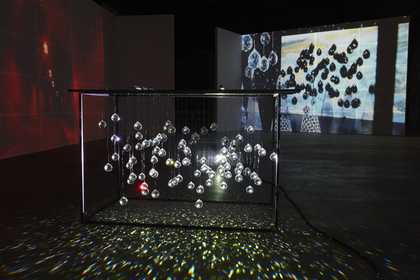
Joan Jonas, Reanimation © Joan Jonas : Artists Rights Society (ARS), New York : DACS, London.
Reanimation started with Halldór Laxness’s 1968 novel Under the Glacier and continued my interest in Iceland. It also introduced the imagery of bees and marked a shift toward more environmental thinking.
Reanimation is an immersive installation in which layers of sound and image overlap and intertwine. It celebrates the beauty of glaciers and the natural landscape, pointing to the fact that glaciers are now melting. Two of Jonas’s My New Theater structures are included – sculptural units specially designed to present what she calls ‘performances in miniature’. In one of the theater boxes, Jonas is heard reading selected passages from Laxness’s Under the Glacier.
Originally developed as a lecture-performance in 2010, Jonas continued to work on Reanimation to make an installation and performance, shown for the first time at the art exhibition dOCUMENTA 13 in 2012. The videos that comprise the installation were mostly shot in the Lofoten Islands, Norway, showing snow-covered mountains in different light conditions, as well as animals such as seals, goats and fish. Jonas includes footage of her drawing animal heads in the snow with black ink, and mixing the ink with chunks of ice. In doing this she connects the act of drawing to nature. Additional sounds from two of the projected videos include a yoik song in the tradition of the indigenous Sami population in Norway, performed and composed by the Norwegian singer Ánde Somby, as well as excerpts of American musician Jason Moran’s soundtrack composed for the performance.



